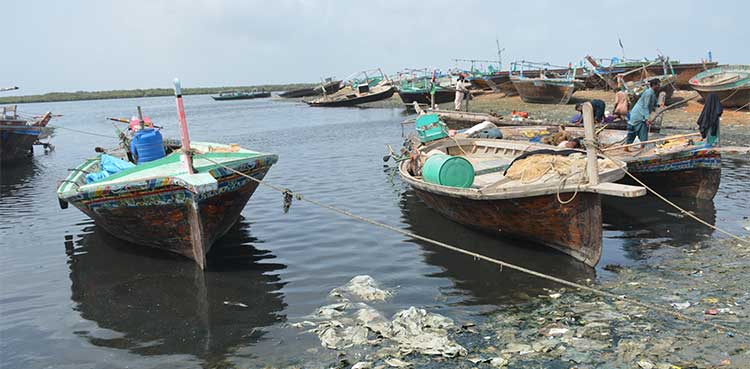Zubida Dablo lives in a small bamboo-and-tin hut on the edge of Chashma Goth, a coastal fishermen’s settlement in Karachi. She shares the modest shelter with her husband and six children.
During high tides, seawater invades their home, flooding the floor and leaving only the elevated bamboo bed dry. “This small hut is all we have,” she says, “so whatever tides bring, we must endure.”
Zubida’s family moved here three years ago after fleeing their ancestral village in the Indus Delta, which became uninhabitable due to rising sea levels. The village, located about one and half hours by boat from Keti Bunder, has been nearly submerged. When they settled in Karachi, they hoped for safety. But the sea seems to have followed them.
Today, Chashma Goth faces the same fate as their native island. During monsoon season or even regular high tides, seawater enters the village, disrupting life and damaging homes. Residents work together to flush the water out, but it takes days—sometimes weeks—to dry. With no proper drainage system, villagers are forced to seek higher ground, often sleeping on rocks and struggling to cook or care for their families during the flooding.
Karachi’s coastline is increasingly vulnerable. The city’s fishing communities, especially in low-lying settlements like Ibrahim Hyderi, Chashma Goth, Syed Paaro, and Gaabo Patt, are already facing the harsh realities of sea level rise. Many of these areas flood regularly during monsoon rains, forcing people to relocate temporarily or suffer repeated damage to their homes.
The rise in sea level is not just a local issue but part of a larger global climate crisis. All over the world, oceans are swelling faster than they have in centuries. Glaciers and ice sheets are melting more rapidly due to rising temperatures, and warmer oceans expand, pushing water levels even higher. While globally the sea has risen by several centimeters over the past three decades, places like Pakistan are particularly exposed due to their geography, poor infrastructure, and lack of long-term planning.
Along Pakistan’s 1,050-kilometer coastline, over two million people live in vulnerable communities. In Karachi alone, nearly a million residents reside in coastal settlements, many of which are informal and lack basic protections against environmental hazards. For these populations, rising sea levels are not a distant concern—they are a daily threat.
One of the contributing factors to worsening conditions is the destruction of mangrove forests. Once abundant along the Sindh and Balochistan coasts, these natural barriers offered protection against storms and tidal surges, while also providing oxygen and absorbing harmful gases. Now, widespread deforestation and encroachment have left the coastline exposed. Without these buffers, seawater flows in more easily, damaging land and homes, and bringing with it disease.
In Chashma Goth, authorities built a sea wall roughly a decade ago in an attempt to shield the community. But the unintended result has been disastrous. Before the wall, floodwaters would eventually recede back into the sea. Now, the water remains trapped behind the wall, lingering for months and turning stagnant. This standing water becomes a breeding ground for illness. Children and the elderly frequently suffer from skin diseases, itching, and infections.
The economic consequences are equally severe. Fishing has been the primary livelihood for generations in these communities, but fish stocks are declining as saline water overtakes freshwater breeding grounds. Boats often cannot launch during flood days, and nets return empty more often than not. For families living day to day, this is the beginning of poverty cycles. Many take loans to rebuild homes or replace damaged equipment, only to be hit by the next high tide or monsoon surge.
Some efforts have been made to adapt. A few families have received support to build homes on raised platforms. But most cannot afford such construction. They continue to live in ground-level shelters, knowing that the next flood is only a storm away. Despite the hardship, some refuse to leave. They feel a deep connection to the land and sea, passed down through generations. “During floods, we move to higher places for a while,” says
Nawaz Ali, a local resident. “But we do not migrate. This is our home.”
What is happening in Chashma Goth is a small part of a much larger pattern. All over the world, coastal cities are confronting the realities of climate change. But for communities like these, the crisis has already arrived. It seeps into their homes, erodes their land, and steals their livelihoods. Without immediate and sustained action—both locally and globally—millions more will face the same fate.
Zubida Dablo’s story is one of resilience, but also of warning. Her hut, barely protected against the sea, stands as a symbol of what is to come if rising waters continue unchecked. It is a quiet, ongoing disaster that threatens not only homes and communities but cultures, histories, and futures. For now, families like hers are holding on—by bamboo poles and sheer willpower—but time is running out.


Leave a Comment